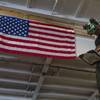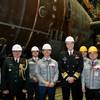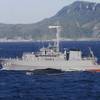A new development within the realm of U.S. Shipbuilding — the new Kvaerner Philadelphia Shipyard (KPSI) is poised to be one of the most efficiently outfitted commercial shipyards in the world. The shipbuilding company, which occupies approximately 114 acres on what used to be the Philadelphia Naval Shipyard, utilizes a section of the former Naval yard, which was closed down in 1996 by the U.S. Government due to lack of funds. Further revitalizing this historical landmark, was KPSI's decision to utilize the yard's original drydocks that date back to WWII. But the facility is hardly stuck in the 1940s as it boasts a full array of modern shipbuilding technology and systems. Recently, Ron McAlear, hailing from Litton Avondale and a U.S. shipbuilding leader for decades, was tapped to lead the new yard to commercial success. Complete with a network of competitive suppliers, this offers the yard the potential to reach the level of achievement that matches the current status of its Finnish and German sisteryards.
Driving up to the front entrance of Kvaerner Philadelphia Shipyard, one is engulfed by not only the size of the yard's new facilities, but by the history that is surrounding the foundation on where the yard is built. The land on which KPSI sits, once occupied the Philadelphia Naval Shipyard that had its heyday during WWII — it constructed a variety of vessels for U.S. Defense, subsequent to the attack on Pearl Harbor, which officially marked U.S. entry into the War. These activities are literally just history and a new generation of U.S shipbuilding is about to begin, not for defense, but for transportation purposes, specifically the domestic U.S. cargo ship market.
KPSI will focus on design, hull construction and partnering in outfitting at its new yard. In fact, the yard is already in the process of constructing a containership with an overall length of 712 ft. (217 m) and beam of 106 ft. (32.2 m). Able to hold a capacity of 2,600 TEUs at a speed of 22.7 knots, the vessel, which is simply called Ship 001 as of press time — does not have a current owner. However, KPSI executives are confident that a potential buyer will emerge in the near future — and not just to purchase the containership. It was confirmed by shipyard executives that the yard is for sale as well.
Its little secret is that KPSI's parent company, Kvaerner, has been selling off its international shipbuilding assets since April 1999, and to date, has sold nine of its operating yards worldwide. Prior to this, a decision had been made in 1997 to establish the KPSI operation - with yard construction commencing the following year. This of course, all occurred prior to Kvaerner's decision to start selling off. How does this effect the Philadelphia yard? According to Eero Makinen, presently senior vice president sales and marketing for Kvaerner Masa-Yards, "operations were not effected by this decision."
He continued that although the Philadelphia Shipyard Development Corp. (PSDC) was concerned about the selling of the yards, it was not something that was of great concern, specifically since Kvaerner's main Masa-yards facilities in Finland are here to stay — the yard is filled to capacity with cruise ship jobs throughout the next few years making it one of the busiest and lucrative yards worldwide.
Another factor that comes into play is that KPSI does not actually own the facility - it is on long-term lease from PSDC. Owned by the State of Pennsylvania, City of Philadelphia and the Delaware River Port Authority, PSDC has not only overseen the design and construction of the yard, but is also facilitating the workforce training during the early years of the yard's operation. To date, $430 million of public grants have been designated for these functions.
Training Produces Quality Results
On a recent visit to KPSI, MR/EN toured the central function of the yard — its fabrication shop, which is housed in a large blue and silver building surrounded by the Delaware and Schuylkill Rivers. While the yard does contain a grand block shop, paint shop, executive offices, and building and outfitting docks, the fabrication shop marks the commencement of a vessel being taken from paper to reality.
Occupying 428,000 sq. ft., (approximately the size of 7.5 football fields) the fabrication shop is currently home to more than 200 KPSI workers, who will fabricate steel plate and profile components, prepare pipe and equipment modules and assemble ship sections up to 300 tons. In addition, the grand block shop measures 85,000 sq. ft. and two paint shops are each capable of holding a 600-ton grand block. A gantry crane that can lift 660 tons and two 50-ton cranes serve the graving dock — in addition to a pair of two heavy lift transports with a capacity of 420 tons each.
The yard also holds an intermediate 1,000 x 150 ft. (335 x 45 m) drydock (a piece of the original Navy yard), which has an intermediate gate and skidding system allowing for simultaneous assembly of two hulls. Furthering its commitment to advanced technology, much of KPSI's production will be completed by robotic devices, such as automatic welding equipment that includes an off-line robot welding system. Its benefit is that it can perform difficult welding tasks that may be difficult for a welder to reach - not to mention a precision that could be surpassed by even the most experienced welder.
Even though the yard is forging ahead into the new millennium by embracing new robotic technology, this does not mean that it will balk at hiring skilled workers to construct vessels. In fact, KPSI, which as of December 2000, employs approximately 385 workers — expects to hold approximately 970 individuals (including management and production) in active employment by this time next year. The yard has held a series of job fairs where potential workers who possess the skills that the yard is looking for can apply on-site for a variety of production positions.
At press time, KPSI was averaging a total of 25 new hires a week from these fairs. Many who apply are either former employees of the Naval Shipyard, and all must have prior experience. The bottom line is that all must be willing to undergo Kvaerner's rigorous training program, which commences upon hiring. Similar to the same process that workers at the Masa and Warnow yards undergo, the program begins with a 12 week course that covers welding, outfitting, pipe welding and machine operation — followed by two addition four week sessions. The total process lasts approximately 22 weeks or five months, which may seem lengthy, but according to Pertti Rinta-Pantilla, vice president, Production, "The length of training is long, but workers are released to production quite soon after training," he said. "From European standards this time frame (five-six months) is the standard amount of time to train welders and outfitters."
McAlear Takes the Helm
Shortly before press time, Kvaerner announced that it had elected Ron McAlear to head the new KPSI venture as president and CEO. McAlear, who has been an intricate part of the U.S. shipbuilding industry, most recently as vice president of Operations at Litton Avondale Industries, had been following the KPSI project from the very beginning. These two components melded together, prompted Kvaerner to call upon McAlear in September to discuss the head position at the yard. Excited at the prospect of leading this yard was something that McAlear wanted to pursue, and after several exchanges between him and Kvaerner executives, there was no doubt that he shared KPSI's vision — establishing it as the leading commercial shipyard in the U.S.
A firm believer in teamwork and, "open and honest communication among employees," McAlear can't stress enough that these are the core ingredients for achieving the yard's goal of becoming number one.
"A successful operation is built by the people involved…Everyone is a part of it and has a role to play to produce a quality product," McAlear said.
He is also committed to operating a safe yard, in fact, he cites this as something that is high on his list of priorities. "Safety is number one," McAlear said. "A safe yard is a good yard — you don't make any compromises when people's lives are concerned."
While those who work in the shipyard need to have a safe environment, they also need to be properly trained — McAlear is steadfastly pledged to running an operation that follows the guidelines based upon Kvaerner's training programs. He's all about helping employees finding their niche within the company, and will work to find the right position for them — even if it means moving them from the initial department where they began. He mentioned that if a specific employee was not performing up to his/her potential, he would provide them with additional training and resources that they would need to raise their skills and performance level.
McAlear's game plan to further KPSI's future not only lies in "skilled technicians applied to a world class shipbuilding facility," but within himself, and how he will work to improve the yard by thoroughly scrutinizing the operation — from all sides.
No stranger to the maritime industry, McAlear, who was born and raised in Boston, Mass., experienced his first taste of the maritime world when he signed up for a sailing course that was given by the Boston Parks & Recreation Department. At just 15, he knew that he wanted to have a career that dealt with the sea. He took the necessary steps in high school to accomplish this, and did so by applying and accepting an offer to enroll at the Massachusetts Maritime Academy. After graduating in 1968 with a B.S. in Marine & Electrical Engineering, McAlear furthered his education at both the University of Michigan and MIT where he received a B.S.E. Naval Architecture & Marine engineering in 1973, and an S.M. Naval Architecture & Marine Engineering in 1974, respectively.
After MIT, he began his tenure at Avondale as a naval architect Advanced Programs and Marketing — a position he stayed in until 1979, when he left to join Waterman Steamship Corp. as assistant to senior vice president Marine Operations. He remained at Waterman until 1985, when he departed for a position at Iron Mountain, Mich.-based Lake Shore as vice president Marine Defense Division. While there, he received an offer in 1988 to return to his roots at Avondale, this time as an intricate part of strategic planning and marketing within the company's Shipyard Division. He eventually worked his way up to corporate vice president of Advanced Programs and Marketing in December 1997, and then in 1999 to what was until now, the apex of his career — vice president of Operations at Litton Avondale Industries. Leading a workforce of approximately 5,000 employees, McAlear was responsible for production, engineering, material, planning and scheduling, until Kvaerner tapped him for his current position this fall.
When word got out that McAlear accepted his new position, the executives at Litton Avondale were disappointed to hear of his departure — on both a personal and professional level. But, they also recognized that this was the kind of opportunity that was a chance in a lifetime. According to McAlear, they are probably one of the most classy, professional groups of individuals that he has dealt with throughout his career.
While the U.S. as a whole will never be able to match the orderbooks of the Asian yards in some areas, such as VLCCs and bulk carriers, McAlear feels that the U.S., and KPSI will, in the future, be able to compete with the European yards in the realm of higher value-added, higher-quality vessels, such as containerships, shuttle tankers and reefer vessels. The yard is on the right track to achieving this with a strong leader, who is a firm supporter of the Jones Act. Mixed together, these two components have positioned the company to raise the "big six" group of shipyards to "big seven."
McAlear would strongly agree, as he feels the company has an excellent opportunity to capture that position in this coveted group with two assets that the company holds : European technology coupled with world-class facilities.
Sponsored Content
Lower carbon intensity fuels to support your operations

Subscribe for
Maritime Reporter E-News
Maritime Reporter E-News is the maritime industry's largest circulation and most authoritative ENews Service, delivered to your Email five times per week










